BIOGRAPHY
The man known as Maelstrom is a unique half breed of the Inhuman and Deviant subspecies of humanity. Over a century ago, his father Phaeder was a brilliant Inhuman geneticist whose work skirted the limits of the law in Attilan. The ruling House of Agon brought Phaeder before the Council of Genetics and accused him of performing outlawed experiments. Phaeder accepted the accusations and countered that nothing should be illegal in the pursuit of true science. Realizing 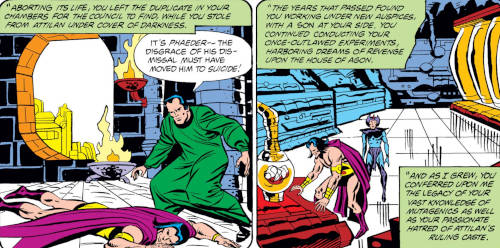 that his time in Attilan was over, Phaeder produced a clone of himself and left it dead in his laboratory. Agon and his supporters believed Phaeder was dead, allowing the renegade to continue his work in exile. [Marvel Two-In-One #72]
that his time in Attilan was over, Phaeder produced a clone of himself and left it dead in his laboratory. Agon and his supporters believed Phaeder was dead, allowing the renegade to continue his work in exile. [Marvel Two-In-One #72]
Phaeder spent time in Deviant Lemuria, contributing to and learning from one of the oldest scientific civilizations still in existence on Earth. The Deviants sought out Phaeder for his genetic research, hoping he could assist with the stabilization of the ever-changing Deviant genome. He took a mate named Morga and together they conceived a son. Phaeder eventually lost favor among the Deviants, though it is uncertain whether due to a regime change, the failure of his work, disapproval of his coupling with Morga or some other reason. Phaeder’s wife was killed and his son sent to the Deviant slave pens. Phaeder and his son eventually escaped from the slave pens and made a new home, independent of Maelstrom’s two parent species. [Avengers (1st series) #248, Quasar #21]
Not much is known of Maelstrom’s childhood and upbringing beyond this. Even his name is apparently self-given at some point after devising his powers later in life. He is known to have loved his father deeply, but he inherited Phaeder’s bitterness towards the Inhumans and their Genetics Council. [Marvel Two-In-One #72] His own experience with the Deviants led Maelstrom to develop a personal hatred towards the people who murdered his mother, possibly for the sole crime of giving birth to him. [Avengers (1st series) #248] He once had a Deviant lover named Medula, perhaps while still in the slave pens. However, Maelstrom rejected Medula and left her behind, due to a combination of projecting his hatred of the entire Deviant race onto her, and self-hatred for giving in and loving her anyway. As a result, Maelstrom was unaware for decades that Medula gave him a son, Ransack the Reject, who was traditionally beautiful to Inhumans or Eternals, and therefore hideous to his fellow Deviants. [Eternals (1st series) #4, Fantastic Four Unlimited #10]
Maelstrom and Phaeder lived in seclusion at various hidden laboratories, continuing their work in 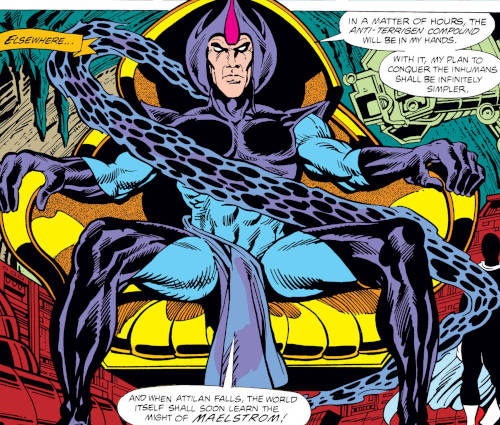 genetics. Several decades ago, the Inhumans moved all of Attilan from an island in the Atlantic to “the Great Refuge,” deep in the Himalayan Mountains. Phaeder and Maelstrom made their main lab in the underwater hollow of Old Attilan, extracting residual samples of raw Terrigen from the ground to fuel their research. It was through this Terrigen-derived compound that Maelstrom derived his bio-kinetic powers.
genetics. Several decades ago, the Inhumans moved all of Attilan from an island in the Atlantic to “the Great Refuge,” deep in the Himalayan Mountains. Phaeder and Maelstrom made their main lab in the underwater hollow of Old Attilan, extracting residual samples of raw Terrigen from the ground to fuel their research. It was through this Terrigen-derived compound that Maelstrom derived his bio-kinetic powers.
Phaeder’s dedication to pure science made him willing to share his knowledge with other collaborators, encouraging the intellectual pursuit of research. Sometimes they directly aided other scientists in exchange for sharing data from any discoveries their partner might make. On other occasions, they discreetly made scientific data available to others, hoping to learn from them remotely. After stalking him at a Geneva conference on genetics in the 1920’s, Phaeder was responsible for giving Herbert Wyndham the key to unlocking the genetic code. This scientific data greatly furthered Wyndham’s own research and the creation of his New Men as the High Evolutionary. [X-Factor Annual #3] When Wyndham conceived his Citadel of Science as a pure research facility, Phaeder returned to provide him with the Moloids, a Deviant-constructed slave race of laborers. [Silver Surfer Annual #4] When Miles Warren became the Jackal, his work in cloning and recombinant viruses was devised from Phaeder’s efforts, either through direct support or carried down through Warren’s former partner, Wyndham. [Scarlet Spider Unlimited #1]
Other attendees of that fateful Geneva conference also received attention. Some of Phaeder’s research made its way into the hands of Arnim Zola the Bio-Fanatic, leading to his work with malleable bio-constructs and transferring human consciousness into clone forms. [Captain America (1st series) #209, Avengers Annual #13] Contributions were made to Wladyslav Shinski of the Enclave, which later resulted in artificial biological creations like Adam Warlock. [Fantastic Four (1st series) #66-67] Noah Black also attended Geneva, and his later work as Centurius involving evolutionary acceleration and mental transference into clones strongly suggest shared research as well. A sample of Terrigen was provided to Doctor Hydro, who used it to mutate normal humans into a race of amphibians. [Sub-Mariner (1st series) #61, Marvel Two-In-One #71] Finally, one of Maelstrom and Phaeder’s abandoned labs was discovered by Magneto and used for his creation of Alpha the Ultimate Mutant. [Defenders (1st series) #15-16]
As the years passed, old age began to weigh on Phaeder. Maelstrom retained his vitality thanks to the Terrigen extract which gave him his powers, but Phaeder had already been too old to weather the process when they formulated it. Maelstrom took direct control over their research endeavors while his father was confined to bed due to his frailty. Maelstrom oversaw a staff of agents and junior scientists at their Old Attilan site so that numerous projects could run simultaneously. Phobius, Helio and Gronk were a trio of humans or Deviants recruited by Maelstrom and  empowered by his Terrigen compound as “Maelstrom’s Minions.” Thanks to his cloning and mind transference technology, Maelstrom arranged for he and his Minions to have functional immortality, even establishing protocols for them to be killed if captured so his secrets could not be uncovered. Maelstrom had an agent called Deathurge, who personally served as their executioner. Maelstrom believed Deathurge was his servant, but Deathurge actually answered to the cosmic aspect of Oblivion.
empowered by his Terrigen compound as “Maelstrom’s Minions.” Thanks to his cloning and mind transference technology, Maelstrom arranged for he and his Minions to have functional immortality, even establishing protocols for them to be killed if captured so his secrets could not be uncovered. Maelstrom had an agent called Deathurge, who personally served as their executioner. Maelstrom believed Deathurge was his servant, but Deathurge actually answered to the cosmic aspect of Oblivion.
Most of Dr. Hydro’s amphibians on Hydro-Base were abducted by him and turned into green-scaled mutations against their will. The plight of the people of Hydro-Base came to the attention of Mr. Fantastic and the Inhumans when their scaly appearance was compared to Triton of the Royal House of Agon. Their studies confirmed that Hydro’s work was based on Terrigen. Reed Richards and the Inhumans’ geneticists developed an anti-Terrigen compound which would reverse the transformations on Hydro-Base. Terrigenesis was sacred to the Inhumans, however, and so this anti-Terrigen would be heavily guarded at Hydro-Base by the Inhumans Gorgon and Karnak, as well as their allies Stingray and the Thing.
Maelstrom’s covert monitoring of Attilan and Hydro-Base alerted him to this new development, and he was intrigued by the scientific value of an anti-Terrigen. He dispatched his Minions to recover a sample of the compound. Although the trio was apprehended, Helio got a self-mobilizing capsule into the sea which returned to Maelstrom’s lab in Old Attilan. Maelstrom summoned 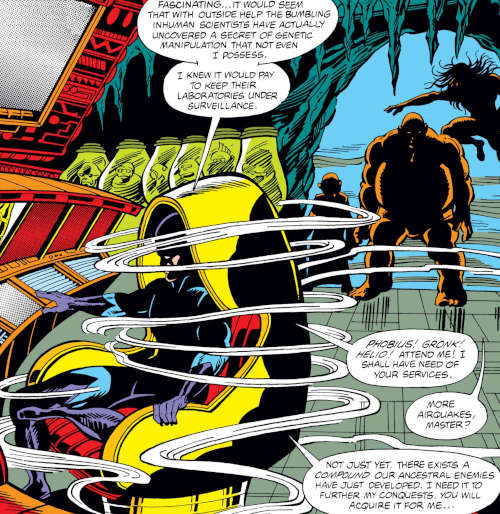 Deathurge and dispatched the wraith-like assassin to execute his captive henchmen. Deathurge boldly killed the three in front of several members of the Fantastic Four and the Inhumans, then escaped without incident. Although the Minions never talked, their corpses still carried signs of Terrigenesis, furthering the hypothesis that another source of Terrigen was in play outside of Attilan.
Deathurge and dispatched the wraith-like assassin to execute his captive henchmen. Deathurge boldly killed the three in front of several members of the Fantastic Four and the Inhumans, then escaped without incident. Although the Minions never talked, their corpses still carried signs of Terrigenesis, furthering the hypothesis that another source of Terrigen was in play outside of Attilan.
Based on this information, Gorgon, Karnak and the Thing explored the undersea passages of Old Attilan and stumbled upon Maelstrom’s laboratory. Black Bolt, king of Attilan and son of Agon, soon followed after his missing cousins when they failed to report back. Maelstrom prized his secrecy, but he was eager to take revenge on the heir of the man who denounced the House of Phaeder. As a mystery to Black Bolt, Maelstrom took advantage of his superior knowledge of his 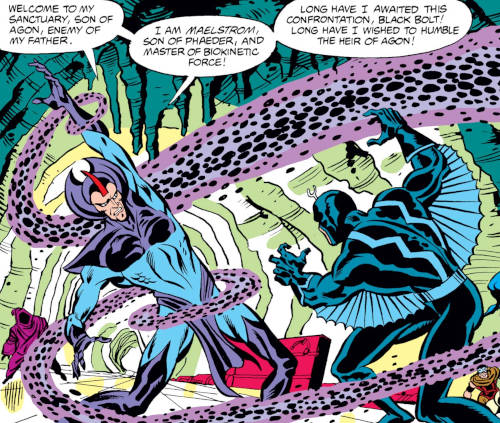 enemy to bio-kinetically drain the electron-based strength of Agon’s scion. As they grappled, Maelstrom fed on Black Bolt’s energy and revealed he had launched a missile containing the anti-Terrigen compound at Attilan itself. The Inhuman civilization that rejected Phaeder’s genius would now suffer in his absence. Black Bolt was forced to flee from the duel to pursue and intercept the missile before his people were lost.
enemy to bio-kinetically drain the electron-based strength of Agon’s scion. As they grappled, Maelstrom fed on Black Bolt’s energy and revealed he had launched a missile containing the anti-Terrigen compound at Attilan itself. The Inhuman civilization that rejected Phaeder’s genius would now suffer in his absence. Black Bolt was forced to flee from the duel to pursue and intercept the missile before his people were lost.
Maelstrom remained to amuse himself on the other intruders, but Ben Grimm 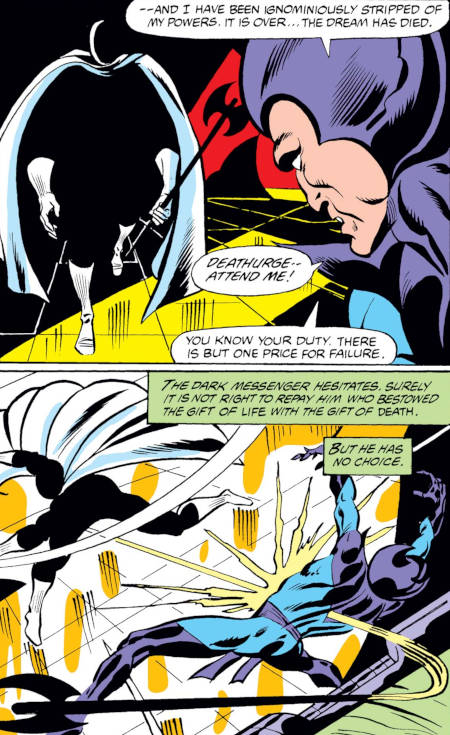 was more cunning than he looked. The Thing spotted the anti-Terrigen compound and splattered it on Maelstrom, depriving the geneticist of his bio-kinetic abilities. He fled to regroup, and also learned from his monitors that Black Bolt was successful in stopping the missile. Realizing his only recourse was escape by the sweet release of death, Maelstrom rushed to his father’s side to say good-bye and then ordered Deathurge to attend him. The assassin struck Maelstrom dead as Gorgon’s shockwaves began bringing the laboratory down around them. Maelstrom would soon revive in another laboratory far away, thanks to automated systems triggered by his death. Phaeder was too old and too ill for the clone transference process, though, and the aged exile passed away in his sleep shortly after his son was killed. [Marvel Two-In-One #71-72]
was more cunning than he looked. The Thing spotted the anti-Terrigen compound and splattered it on Maelstrom, depriving the geneticist of his bio-kinetic abilities. He fled to regroup, and also learned from his monitors that Black Bolt was successful in stopping the missile. Realizing his only recourse was escape by the sweet release of death, Maelstrom rushed to his father’s side to say good-bye and then ordered Deathurge to attend him. The assassin struck Maelstrom dead as Gorgon’s shockwaves began bringing the laboratory down around them. Maelstrom would soon revive in another laboratory far away, thanks to automated systems triggered by his death. Phaeder was too old and too ill for the clone transference process, though, and the aged exile passed away in his sleep shortly after his son was killed. [Marvel Two-In-One #71-72]
Maelstrom recovered from this setback to seek new avenues of experimentation and power. He 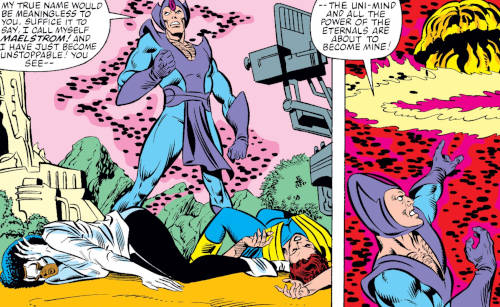 resurfaced discreetly in Olympia, the city of the Eternals. Maelstrom saw an opportunity to acquire vast amounts of energy from the Eternals as they prepared for the ritual of the Uni-Mind, where their entire race would combine into a gestalt entity of immense power. Maelstrom fabricated special equipment designed to convert the impressive psionic energy of the Uni-Mind into an energy source his bio-kinetic powers could absorb. Once the ritual began, Maelstrom snared the Uni-Mind in his power siphon device and adjusted his power harness to collect that energy. Maelstrom also used leech manacles to incapacitate the Eternals’ guests, Wasp and Captain Marvel of the Avengers, but left them alive to witness his triumph.
resurfaced discreetly in Olympia, the city of the Eternals. Maelstrom saw an opportunity to acquire vast amounts of energy from the Eternals as they prepared for the ritual of the Uni-Mind, where their entire race would combine into a gestalt entity of immense power. Maelstrom fabricated special equipment designed to convert the impressive psionic energy of the Uni-Mind into an energy source his bio-kinetic powers could absorb. Once the ritual began, Maelstrom snared the Uni-Mind in his power siphon device and adjusted his power harness to collect that energy. Maelstrom also used leech manacles to incapacitate the Eternals’ guests, Wasp and Captain Marvel of the Avengers, but left them alive to witness his triumph.
Maelstrom’s siphoning process was not instantaneous, however, and it allowed time for the Vision and other Avengers to come to the rescue. Vision’s intangible body disrupted Maelstrom’s harness, interfering with the power transfer. Once Maelstrom was off-balance, the Scarlet Witch prevented him from restarting the transfer by hexing the Uni-Mind to split back into the composite Eternals. As they recovered, Maelstrom soon found himself facing both the Avengers and the Eternals of Olympia. The Vision calculated the limitations 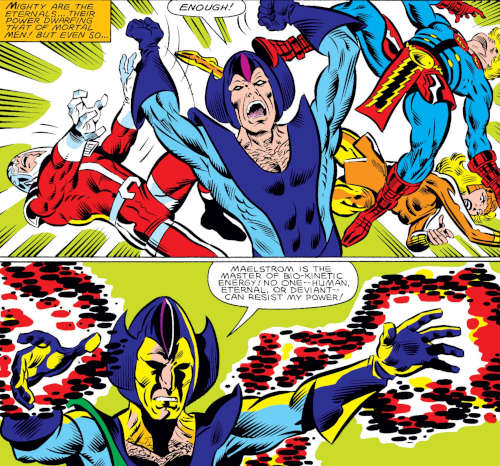 of Maelstrom’s power, directing the Avengers to strike him with non-kinetic attacks from distances safe enough to protect them from his kinetic siphoning. As his energy reserves were dangerously depleted, Maelstrom again called upon Deathurge to attend him. The lurking assassin cast his ebon spear and moments later Maelstrom lay dead, again, in the plaza of the Eternals. [Avengers (1st series) #247-248]
of Maelstrom’s power, directing the Avengers to strike him with non-kinetic attacks from distances safe enough to protect them from his kinetic siphoning. As his energy reserves were dangerously depleted, Maelstrom again called upon Deathurge to attend him. The lurking assassin cast his ebon spear and moments later Maelstrom lay dead, again, in the plaza of the Eternals. [Avengers (1st series) #247-248]
When Maelstrom soon awakened in another cloned body at his latest secret complex, he was angry with his “servant,” Deathurge. The assassin was in position to see the Avengers’ approach, yet he did nothing to stop Vision’s assault or even alert Maelstrom. Now Maelstrom had used up his last clone, and it would be some time before another fully cultivated body would be ready. Deathurge merely made it clear to Maelstrom that he did not serve the scientist, only the scientist’s death-urge, an important distinction for the future. Nevertheless, briefly connecting with the Uni-Mind had provided Maelstrom with the knowledge necessary to carry out a new scheme for ultimate power. [Avengers (1st series) #249]
[Note: Maelstrom and Deathurge’s relationship is a little fuzzy. Early stories indicate Maelstrom created or empowered Deathurge, like his other Minions. However, Deathurge is later revealed to be an agent of Oblivion and the cosmic representation of the suicidal urge, drawn to people who want to die and helping facilitate this. He “serves” Maelstrom the way he serves all suicidal people, by killing them when they want to die. Deathurge’s successor, Doorman of the GLA, was a powered being before being chosen by Oblivion. Perhaps Maelstrom did grant Deathurge his powers and then he switched loyalties when Oblivion chose him as his avatar.]
Maelstrom created or empowered Deathurge, like his other Minions. However, Deathurge is later revealed to be an agent of Oblivion and the cosmic representation of the suicidal urge, drawn to people who want to die and helping facilitate this. He “serves” Maelstrom the way he serves all suicidal people, by killing them when they want to die. Deathurge’s successor, Doorman of the GLA, was a powered being before being chosen by Oblivion. Perhaps Maelstrom did grant Deathurge his powers and then he switched loyalties when Oblivion chose him as his avatar.]
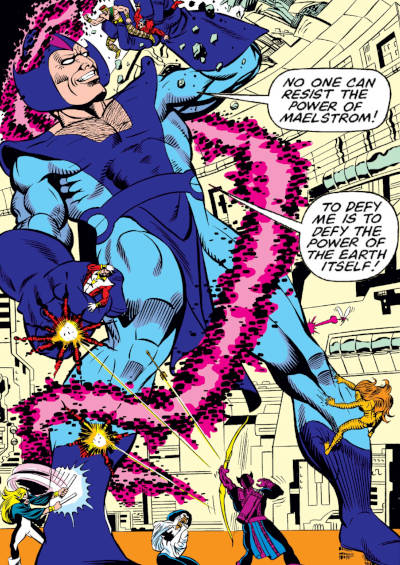
At his new base near Tierra del Fuego, Maelstrom used the knowledge he gleaned from the Uni-Mind to craft his energy governor, harnessing the kinetic energy of the Earth itself. The largest source of motion he ever attempted to siphon, Maelstrom’s equipment actually started slowing the rotation of the entire planet as he physically absorbed this near limitless power. With the death of Phaeder, Maelstrom no longer had any attachment to the world of his birth. He intended to drain the world until it was dead and lifeless, and then use this vast power to travel the stars and visit other civilizations. The Avengers detected the effect on the Earth’s rotation and tracked down Maelstrom’s base. By the time they fought through the Minions of Maelstrom, however, they discovered their foe had already reached colossal proportions.
Maelstrom’s power and his ability to absorb more power were both unprecedented at this scale. He shrugged off attacks that previously would have given him pause and captured three of the Avengers’ most powerful members (Hercules, Starfox and Wonder Man) in a containment sphere that made them an additional kinetic battery for his abilities. The Vision determined which equipment controlled the energy governor due to a powerful defensive field that protected it, keeping him from stopping or interfering with the transfer. However, at Starfox’s suggestion, the Scarlet Witch’s hexes managed to increase the transfer instead. The energy governor was intended to feed Maelstrom a progressively controlled level of excess power, but even he couldn’t 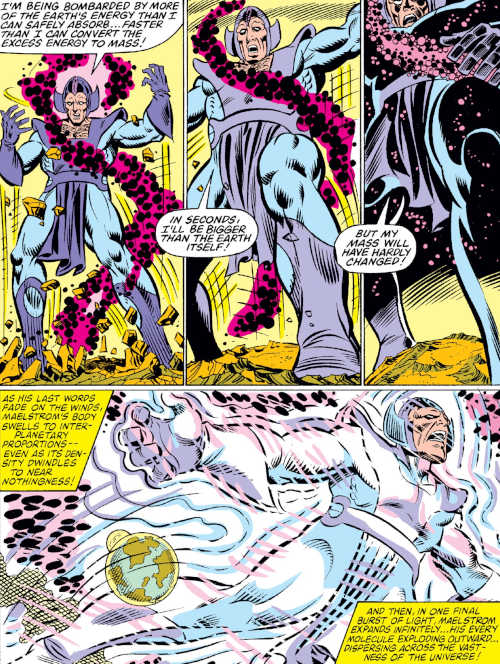 support the kinetic motion of an entire world in one body. Maelstrom needed to increase in size and mass proportionately but, with the governor’s fail-safes gone, he continued to expand faster than his converted mass could keep up. Maelstrom grew to hundreds of feet tall, then thousands, then to interplanetary proportions. However, without a relative increase in mass, his molecules drifted further and further apart. Eventually, they could no longer retain even a semblance of bonds, and Maelstrom was dispersed into infinity. [Avengers (1st series) #250]
support the kinetic motion of an entire world in one body. Maelstrom needed to increase in size and mass proportionately but, with the governor’s fail-safes gone, he continued to expand faster than his converted mass could keep up. Maelstrom grew to hundreds of feet tall, then thousands, then to interplanetary proportions. However, without a relative increase in mass, his molecules drifted further and further apart. Eventually, they could no longer retain even a semblance of bonds, and Maelstrom was dispersed into infinity. [Avengers (1st series) #250]
